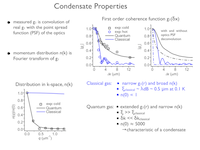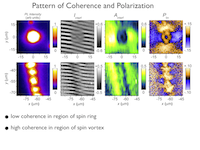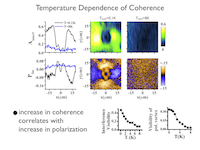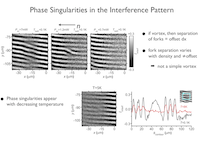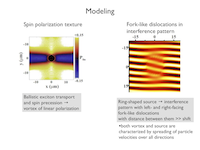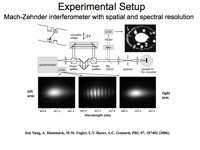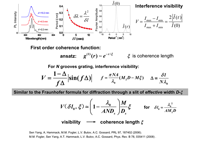Spontaneous coherence in a cold exciton gas |
|
Excitons, bound pairs of electrons and holes, form a model system to explore the quantum
physics of cold bosons in solids. Cold exciton gases can be realized in a system of indirect
excitons, which can cool down below the temperature of quantum degeneracy due to their long
lifetimes. Here, we report on the measurement of spontaneous coherence in a gas of indirect
excitons. We found that extended spontaneous coherence of excitons emerges in the region of
the macroscopically ordered exciton state and in the region of vortices of linear polarization.
The coherence length in these regions is much larger than in a classical gas, indicating a
coherent state with a much narrower than classical exciton distribution in momentum space,
characteristic of a condensate. We also observed phase singularities in the coherent exciton
gas. Extended spontaneous coherence and phase singularities emerge when the exciton gas is
cooled below a few Kelvin.
A.A. High, J.R. Leonard, A.T. Hammack, M.M. Fogler, L.V. Butov, A.V. Kavokin, K.L. Campman, A.C. Gossard, Spontaneous Coherence in a Cold Exciton Gas, arXiv:1109.0253v2 (2011), Nature 10.1038, 10903 (2012). A.A. High, J.R. Leonard, A.T. Hammack, Sen Yang, M.M. Fogler, L.V. Butov, T. Ostatnicky, M.R. Vladimirova, A.V. Kavokin, K.L. Campman, A.C. Gossard, Spontaneous Coherence in a Cold Exciton Gas, Spin Currents in a Coherent Exciton Gas, CLEO/QELS, May 7-11, 2012, San Jose, CA. |
|
Effect of spatial resolution on the estimates of the coherence length |
|
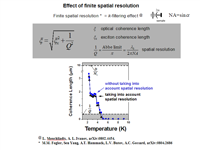
|
We evaluate the effect of diffraction-limited resolution of the optical system on the estimates of the coherence length of two-dimensional excitons deduced from the interferometric study of the exciton emission. The results are applied for refining our earlier estimates of the coherence length of a cold gas of indirect excitons in coupled quantum wells. We show that the apparent coherence length is well approximated by the quadratic sum of the actual exciton coherence length and the diffraction correction given by the conventional Abbe limit divided by π. In practice, accounting for diffraction is necessary only when the coherence length is smaller than about one wavelength. The earlier conclusions regarding the strong enhancement of the exciton coherence length at low temperatures remain intact. M.M. Fogler, Sen Yang, A.T. Hammack, L.V. Butov, and A.C. Gossard, Effect of spatial resolution on the estimates of the coherence length of excitons in quantum wells, arXiv:0804.2686v2 (2008); Phys. Rev. B 78, 035411 (2008). |
Coherence Length of Cold Exciton Gases in Coupled Quantum Wells |
|
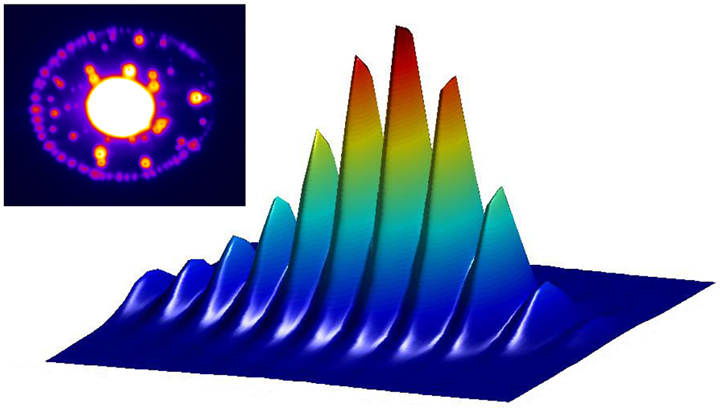
|
A Mach-Zehnder interferometer with spatial and spectral resolution was used to probe spontaneous coherence in cold exciton gases, which are implemented experimentally in the ring of indirect excitons in coupled quantum wells. A strong enhancement of the exciton coherence length is observed at temperatures below a few Kelvin. The increase of the coherence length is correlated with the macroscopic spatial ordering of excitons. The coherence length at the lowest temperature corresponds to a very narrow spread of the exciton momentum distribution, much smaller than that for a classical exciton gas. Sen Yang, A.T. Hammack, M.M. Fogler, L.V. Butov, and A.C. Gossard, Coherence length of cold exciton gases in coupled quantum wells, cond-mat/0606683 (2006); Phys. Rev. Lett. 97, 187402 (2006). |




